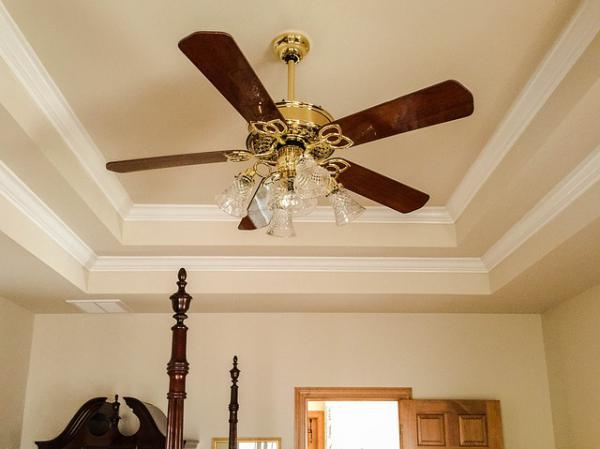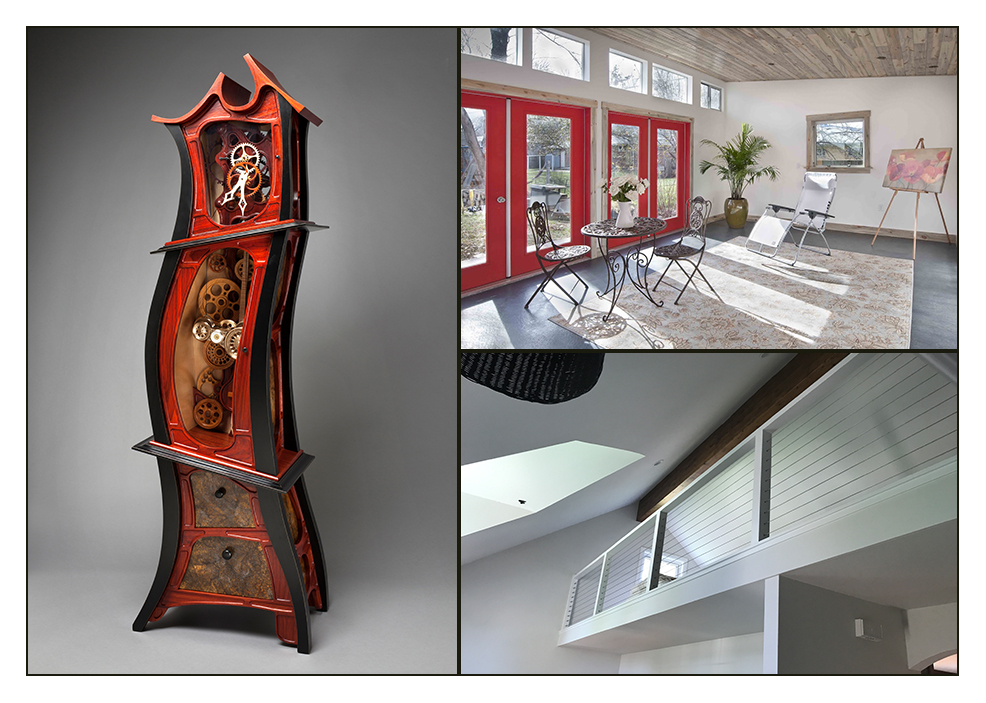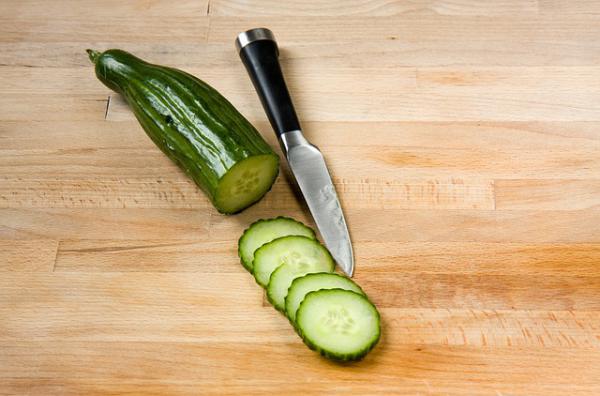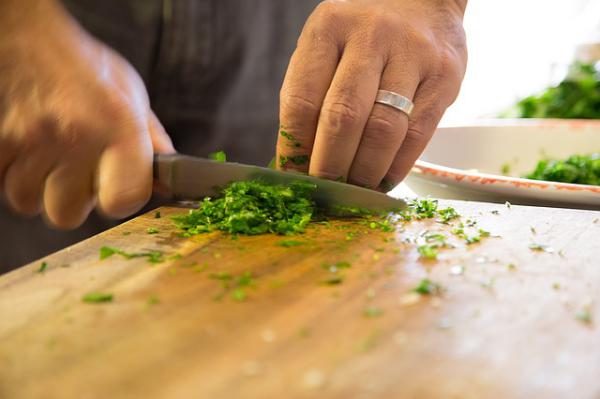Interior Trim & Moulding Types and Uses
Serving Colorado and Wyoming including Fort Collins and Denver
April 26, 2018
The interior walls of a home or office are often not complete without application of a moulding type. These mouldings (sometimes spelled moldings) are primarily for aesthetic purposes but also allow a building’s walls to combat wear and tear over time. By installing appropriate mouldings throughout a home the finished look will be significantly improved by adding highlighted features in important areas depending on the particular type of moulding selected.
While a majority of individuals often focus on the larger components of a construction project, it is attention to these details which can make or break the desired outcome. By understanding what each type of moulding is and the purpose it serves then a homeowner can begin to make informed decisions which will not only improve the look of their home or office but also lengthen its livelihood.
The most common types of mouldings used are Base, Base Shoe, Case, Crown, Chair Rail, Header, Plinth, and Cove. Following is a review of each, including use and benefits derived from inclusion during a project.
Serving to cover the joint between wall and flooring, baseboards not only are aesthetically appealing but also help to keep these joint adhesions protected.
One of the most important factors to consider when installing base shoe moulding is to remember that the moulding nails into the wall and not the flooring.
The matching mouldings and rise from base moulding to case moulding where connected at doorways or pass through openings help rooms and hallways to maintain a specific flow and pleasing appearance.
Crown moulding has a rich history dating back to the Greek Empire having been used throughout time in similar fashion. Unlike base moulding, crown moulding is often used to draw the attention of viewers eyes upwards and can appear to make the room larger than reality.
The chair rail moulding can help to separate a room and add dimension within an open concept. However, the railing should be appropriately applied, typically at about one-third of the wall height. If the railing exceeds this height then a room can look and feel shorter than in actuality while a perfect height will add substance and purpose.
While serving the purpose of outlining these figures within a room, header moulding often differentiates from the normal pattern used to match baseboards or room crown moulding. The header moulding is a unique design drawing attention to the doorway or window for which it is utilized.
The plinth moulding is used as a decorative function while adding a layer of protection for joint adherences of two different types of moulding.
For decades, Sears Trostel has been at the forefront of the lumber and millwork industries. Having proudly served this community with quality and integrity has created multiple repeat consumers, which has also benefited all of our customers by implementing faster turnaround times for all. Providing custom wood floors, wooden countertops, cabinets, John Boos Blocks, and many other wooden assessments, we are proud to offer the best value without compromising any of the quality you would expect and deserve. Our business has a storied history of doing all things the right way, the first time. Our manufacturing processes are unique in this industry and allow for unrivaled flexibility in custom profiles. Also, our commitment to quality has earned us the trust of our customers through Colorado, Wyoming, and many other surrounding areas.
Feel free to contact us today with your needs or visit our retail sales and showroom located at 1500 Riverside Avenue in Fort Collins, Colorado. For commercial and residential sales please call 970-482-1928 or for wholesale and manufacturing, 970-482-0222 or 800-950-1928 with any other general questions about our products and services. We can also be reached by email at Sales@sears-trostel.com as we look forward to showing you the effects quality beautiful natural woods can have.
Read More...
While a majority of individuals often focus on the larger components of a construction project, it is attention to these details which can make or break the desired outcome. By understanding what each type of moulding is and the purpose it serves then a homeowner can begin to make informed decisions which will not only improve the look of their home or office but also lengthen its livelihood.
The most common types of mouldings used are Base, Base Shoe, Case, Crown, Chair Rail, Header, Plinth, and Cove. Following is a review of each, including use and benefits derived from inclusion during a project.
Base Moulding
A common component in almost all construction design, base moulding is known by a variety of names. Skirting board, skirting, floor molding and the most widely accepted baseboard is the accent found along the bottom of most walls.Serving to cover the joint between wall and flooring, baseboards not only are aesthetically appealing but also help to keep these joint adhesions protected.
Base Shoe Moulding
Another lower moulding, base shoe serves a particular purpose and is often implemented in conjunction with hardwood flooring. A small gap occurs when installing hardwood floors between where the floor begins and the wall ends, even with a base moulding, the need for a base shoe fit is often necessary.One of the most important factors to consider when installing base shoe moulding is to remember that the moulding nails into the wall and not the flooring.
Case Moulding
While trim is a general term which covers all types of mouldings, casing is a particular variety. Case moulding is used to enclose doorways and surround windows, covering the connections and cut outs between openings. These mouldings are similar to base mouldings and often both will emulate one another although one may be different in size.The matching mouldings and rise from base moulding to case moulding where connected at doorways or pass through openings help rooms and hallways to maintain a specific flow and pleasing appearance.
Crown Moulding
Opposite of base moulding, crown moulding covers the connection between where walls meet the ceiling. Of similar circumstance, crown moulding is often more eccentric than base moulding and can be comprised of unique designs and angles in addition to varying widths or sizes.Crown moulding has a rich history dating back to the Greek Empire having been used throughout time in similar fashion. Unlike base moulding, crown moulding is often used to draw the attention of viewers eyes upwards and can appear to make the room larger than reality.
Chair Rail Moulding
Widely believed to serve the purpose of protecting chair backs from causing damage to walls, the chair rail has evolved into more of a useful tool. While the original implementation of this particular type of moulding may have been for just that, the architectural aspects now associated with the use of a chair rail moulding can be extremely beneficial.The chair rail moulding can help to separate a room and add dimension within an open concept. However, the railing should be appropriately applied, typically at about one-third of the wall height. If the railing exceeds this height then a room can look and feel shorter than in actuality while a perfect height will add substance and purpose.
Header Moulding
This moulding type is utilized for creative flair and can add eccentric accents to any room by providing unique concepts atop windows and door frames. Header moulding is the top piece of case moulding and can easily be considered as the crown moulding for windows and doors.While serving the purpose of outlining these figures within a room, header moulding often differentiates from the normal pattern used to match baseboards or room crown moulding. The header moulding is a unique design drawing attention to the doorway or window for which it is utilized.
Plinth Moulding
Another trim covering which serves to cover adjoining components, plinth moulding is often utilized where baseboards meet the case moulding of a doorway or cut out inside a home or office.The plinth moulding is used as a decorative function while adding a layer of protection for joint adherences of two different types of moulding.
Cove Moulding
Finally, cove mouldings are implemented where walls and ceilings meet much like crown moulding but more similar to base shoe moulding. The cove moulding not only provides an aesthetically appealing texture to a room but also serves to cover joints needed for construction.For decades, Sears Trostel has been at the forefront of the lumber and millwork industries. Having proudly served this community with quality and integrity has created multiple repeat consumers, which has also benefited all of our customers by implementing faster turnaround times for all. Providing custom wood floors, wooden countertops, cabinets, John Boos Blocks, and many other wooden assessments, we are proud to offer the best value without compromising any of the quality you would expect and deserve. Our business has a storied history of doing all things the right way, the first time. Our manufacturing processes are unique in this industry and allow for unrivaled flexibility in custom profiles. Also, our commitment to quality has earned us the trust of our customers through Colorado, Wyoming, and many other surrounding areas.
Feel free to contact us today with your needs or visit our retail sales and showroom located at 1500 Riverside Avenue in Fort Collins, Colorado. For commercial and residential sales please call 970-482-1928 or for wholesale and manufacturing, 970-482-0222 or 800-950-1928 with any other general questions about our products and services. We can also be reached by email at Sales@sears-trostel.com as we look forward to showing you the effects quality beautiful natural woods can have.
Photo Contest Winners
April 17, 2018
Thanks to everyone who submitted photos in Sear Trostel’s first Photo Contest! We love seeing all the beautiful and creative ways our products are being used — and the photography skills used in showcasing your work.
Winning photos were chosen based on the overall use of materials in the project, photo composition, lighting, and visional interest.
Congratulations to our winners!
1st Place — Edward Darchuk, Darchuck Fine Woodworking — $100 Sears Trostel Gift Card
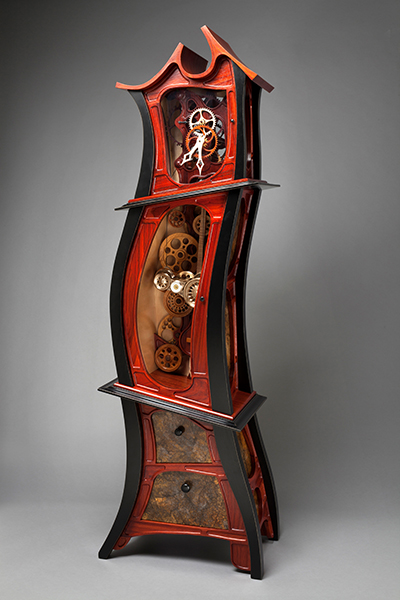
2nd Place — Jean-Pierre Bressieux, Green Home Base Solutions — $20 Sears Trostel Gift Card
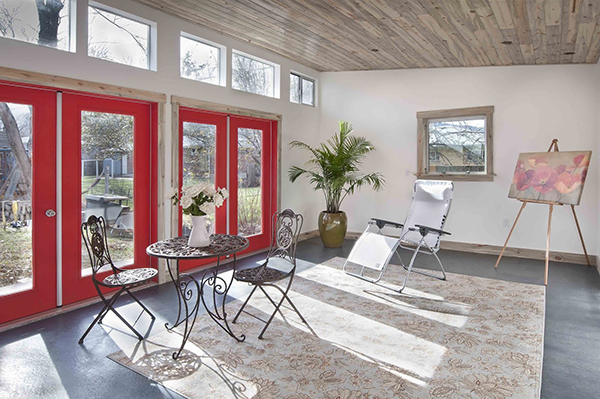
3rd Place — Sean Kleker, Klecker Construction — $10 Sears Trostel Gift Card.
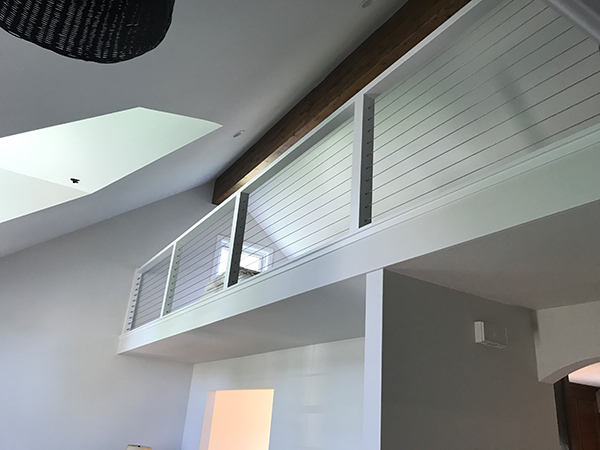
Â
Read More...
Winning photos were chosen based on the overall use of materials in the project, photo composition, lighting, and visional interest.
Congratulations to our winners!
1st Place — Edward Darchuk, Darchuck Fine Woodworking — $100 Sears Trostel Gift Card

2nd Place — Jean-Pierre Bressieux, Green Home Base Solutions — $20 Sears Trostel Gift Card

3rd Place — Sean Kleker, Klecker Construction — $10 Sears Trostel Gift Card.

Â
Why Butcher Block Countertops Are an Essential Component of Any Kitchen
Fort Collins & Denver Area
May 16, 2018
When people are considering remodeling their kitchen, they usually look to new cabinets, flooring, and appliances to make a statement. While these are all a big part of any kitchen remodel, an often overlooked component of this project is the inclusion of a butcher block countertop. People value the importance of having a beautiful, solid and dependable cutting board, but often overlook the butcher block as a valuable kitchen countertop or accent countertop option.
Butcher block countertops are made from straight cuts of wood that have been glued together. They differ from standard cutting boards in that they are thicker and tend to have a larger surface on which to cut. As the name suggests, butcher blocks are primarily used for cutting, filleting, deboning, and quartering of meat.Â
Perhaps the most important aspect of any butcher block countertop is its sturdiness and dependability, the last thing you want to have happen is to be preparing your meals on a flimsy cutting board that can break in half, dull and damage your knifes, and potentially contaminate your food. Â
If you are having a butcher block countertop installed in your home, you will want to consider wood that is unsealed and ready for an oil finished. This is because a sealed countertop will not work as a functional cutting surface. If the wood you select is sealed, it will typically have the surface covered up with a resin or polyurethane, which ultimately will give you a beautiful countertop but you will need to treat it like other traditional countertop surfaces and avoid cutting directly on the surface of a sealed butcher block. Â
In deciding between end grain and edge grain butcher block countertops, you will need to consider a few different factors. First, if you are needing the toughest and most scratch resistant type of butcher block, one that is made of end grain will fit the bill nicely. When you are cutting into it using your knife, it will not scratch as easily, and the knife will actually sink into the wood fibers while you are cutting.Â
This is because end-grain wood is a much more fibrous surface, and its scratches will not show as a result. End-grain wood butcher blocks are arranged in checkerboard patterns due to the construction of the material, and can be an eye-popping accessory for your kitchen as a result.
If you are not intending on doing intensive cutting, an edge-grain butcher block countertop can be the right option for your home. These are usually not as thick, and can show off the colors and character of walnut, maple, oak or cherry hardwoods on your countertop surface. Strips of wood are arranged side by side and grafted together to give edge-grain butcher blocks its appearance. Regardless of if you decide to go with an edge-grain or end-grain butcher block, you can rest easy in knowing that both options are sanitary and long-lasting if properly maintained.
Traditional kitchen counter tops are often made of material that would be easily damaged by the use of knives on their surface, and are usually not constructed to be used for such activities. Butcher block countertops are meant to be used for such cutting processes, and provide a functional staple for your kitchen.
By having butcher block countertops installed in your home, you will also be saving precious space in your kitchen. With the purchase of countless kitchen accessories, your cabinets can fill up faster than you realize. Installing a butcher block as the countertop itself will ensure that you will have one less accessory to put away and fit into your limited cabinet space.
Beyond the obvious benefits of being able to cutting on your countertop surface, there are additional positive attributes that can make a countertop butcher block the perfect choice for your kitchen. Countertop butcher blocks add a layer of classic appeal that standard countertops cannot rival. For homeowners looking to bring a warmer, more natural appearance to their home, installing a wood countertop can be just what the doctor ordered.
In addition to their functionality as a permanent kitchen accessory, butcher block countertops can be used as an accent island within your kitchen. They can also be utilized as a workspace for studies as well as for workshops.Â
Installing a butcher block countertop can also provide a degree of contrast to all of your other kitchen materials. If you kitchen consists primarily of tile, ceramic, and steel or metal appliances, installing wood countertops can provide a proper sense of balance for added visual appeal. Having an overly sterile kitchen can be uninspiring and uninviting, and having wood countertops can be a great way to break up this monotony.Â
If you are interested in having John Boos butcher block countertops installed in your home, or have questions about finding the right countertop style for your kitchen, contact Sears Trostel Lumber and Millwork today. We are more than happy to assist you in finding the best countertop and butcher block style for your home.
Read More...
The Value of a Butcher Block Countertop
Butcher block countertops are a classic addition to your kitchen that create an accommodating environment for any cook. Having a proper surface to cut on is an essential part of your kitchen, and having butcher block countertops installed ensures you will have no shortage of space from which to work.Butcher block countertops are made from straight cuts of wood that have been glued together. They differ from standard cutting boards in that they are thicker and tend to have a larger surface on which to cut. As the name suggests, butcher blocks are primarily used for cutting, filleting, deboning, and quartering of meat.Â
Perhaps the most important aspect of any butcher block countertop is its sturdiness and dependability, the last thing you want to have happen is to be preparing your meals on a flimsy cutting board that can break in half, dull and damage your knifes, and potentially contaminate your food. Â
If you are having a butcher block countertop installed in your home, you will want to consider wood that is unsealed and ready for an oil finished. This is because a sealed countertop will not work as a functional cutting surface. If the wood you select is sealed, it will typically have the surface covered up with a resin or polyurethane, which ultimately will give you a beautiful countertop but you will need to treat it like other traditional countertop surfaces and avoid cutting directly on the surface of a sealed butcher block. Â
Choose Sturdy, Long Lasting Material
If you are thinking about purchasing a butcher block countertop for your kitchen, you are going to want to select one that you know will last and can be counted on to make it through any tough job without being damaged. The John Boos butcher block is a terrific option for fulfilling this requirement. They are made with the highest quality end grain and edge grain wood, and are reliable options for your kitchen.ÂIn deciding between end grain and edge grain butcher block countertops, you will need to consider a few different factors. First, if you are needing the toughest and most scratch resistant type of butcher block, one that is made of end grain will fit the bill nicely. When you are cutting into it using your knife, it will not scratch as easily, and the knife will actually sink into the wood fibers while you are cutting.Â
This is because end-grain wood is a much more fibrous surface, and its scratches will not show as a result. End-grain wood butcher blocks are arranged in checkerboard patterns due to the construction of the material, and can be an eye-popping accessory for your kitchen as a result.
If you are not intending on doing intensive cutting, an edge-grain butcher block countertop can be the right option for your home. These are usually not as thick, and can show off the colors and character of walnut, maple, oak or cherry hardwoods on your countertop surface. Strips of wood are arranged side by side and grafted together to give edge-grain butcher blocks its appearance. Regardless of if you decide to go with an edge-grain or end-grain butcher block, you can rest easy in knowing that both options are sanitary and long-lasting if properly maintained.
Why Make the Decision to Choose Butcher Block Countertops
Butcher block countertops are a terrific method of adding functionality and class to your kitchen in a way that traditional countertops cannot compete with. This option can be a fantastic way to add a layer of functionality to your kitchen that you never thought possible.ÂTraditional kitchen counter tops are often made of material that would be easily damaged by the use of knives on their surface, and are usually not constructed to be used for such activities. Butcher block countertops are meant to be used for such cutting processes, and provide a functional staple for your kitchen.
By having butcher block countertops installed in your home, you will also be saving precious space in your kitchen. With the purchase of countless kitchen accessories, your cabinets can fill up faster than you realize. Installing a butcher block as the countertop itself will ensure that you will have one less accessory to put away and fit into your limited cabinet space.
Beyond the obvious benefits of being able to cutting on your countertop surface, there are additional positive attributes that can make a countertop butcher block the perfect choice for your kitchen. Countertop butcher blocks add a layer of classic appeal that standard countertops cannot rival. For homeowners looking to bring a warmer, more natural appearance to their home, installing a wood countertop can be just what the doctor ordered.
In addition to their functionality as a permanent kitchen accessory, butcher block countertops can be used as an accent island within your kitchen. They can also be utilized as a workspace for studies as well as for workshops.Â
Installing a butcher block countertop can also provide a degree of contrast to all of your other kitchen materials. If you kitchen consists primarily of tile, ceramic, and steel or metal appliances, installing wood countertops can provide a proper sense of balance for added visual appeal. Having an overly sterile kitchen can be uninspiring and uninviting, and having wood countertops can be a great way to break up this monotony.Â
If you are interested in having John Boos butcher block countertops installed in your home, or have questions about finding the right countertop style for your kitchen, contact Sears Trostel Lumber and Millwork today. We are more than happy to assist you in finding the best countertop and butcher block style for your home.
A Visit from Budding Woodworkers
March 19, 2018
In our never ending quest to inspire younger generations to the virtues of creating with wood, we recently welcomed Design Technology students from Lesher Middle School in Fort Collins for a tour of our Airpark facility.
They explored the production floor and had a chance to see our precision saws and moulders in action.
We thank these budding woodworkers, and their teacher Owen Murphy who arranged the visit, for coming to learn about wood and technology used to create wood components for building construction.
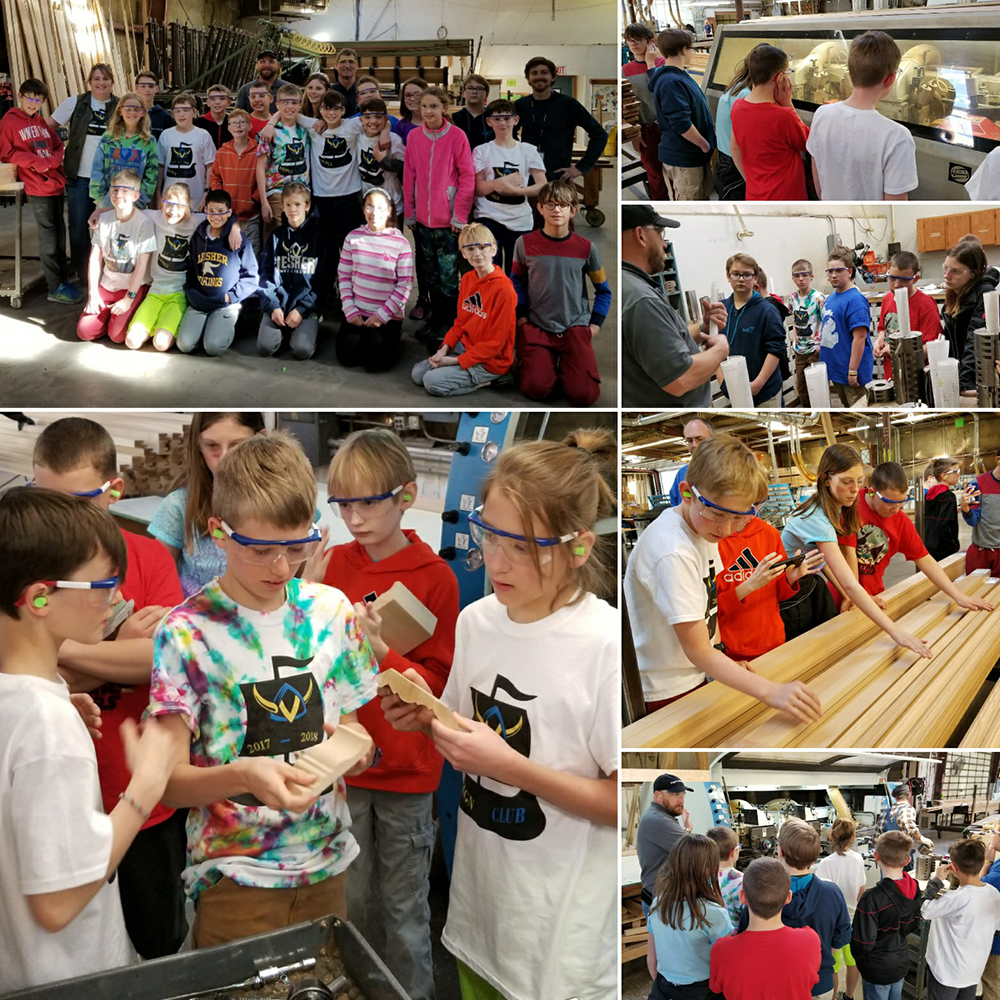
We encourage other teachers and their students to visit. To arrange a tour of our Airpark Dr. and/or Riverside Ave. facilities, please contact Carl Herrmann at 970-482-0222.
Â
Read More...
They explored the production floor and had a chance to see our precision saws and moulders in action.
We thank these budding woodworkers, and their teacher Owen Murphy who arranged the visit, for coming to learn about wood and technology used to create wood components for building construction.

We encourage other teachers and their students to visit. To arrange a tour of our Airpark Dr. and/or Riverside Ave. facilities, please contact Carl Herrmann at 970-482-0222.
Â
Local Fort Collins Lumber Provides Custom Butcher Block Countertops
March 12, 2018
Kitchen design is one of the biggest selling points for homes when on the real estate market and something individuals love to often modify within their own dwellings. While counter top space, storage, shelving, cabinets, and appliances all have an impact on the impression a kitchen can make, adding your own touch is key to enjoying the full experience. Often individuals will seek to modify or change their kitchen once into a new property and these modifications can make all the difference in providing a good space for future family gatherings and plenty of enjoyable time spent together gathering around the table.
For those who enjoy cooking regularly, having a kitchen that not only creates a sense of beauty but is also practical is vitally important. One of the major selling points for those who like to prepare their own meals, whether novice or professional, is a suitable cutting board or useful butcher block. Each of these two components not only can be the focal point of a kitchen but also serve an extremely important purpose while providing a sense of stability to the setting within a modern kitchen - tying the past to the present while maintaining a sincere functionality.
Both regular and custom cutting boards or butcher block countertops will immediately become focal points for your kitchen while maintaining their useful purpose. For the use of each there are three things to consider before implementing the installation of either into a home or commercial kitchen. These include the following areas of design style or type, which is the best fit for your particular kitchen. Purpose, the usefulness of each type of cutting board or entire countertop and finally, the care required for each.
Deciding on which works best for your particular situation depends on your intended use of the product over time. If you are regularly cutting meat, fruits, vegetables, and other ingredients then a permanent countertop butcher block or cutting board may be in your best interest. However, if you are more akin to the occasional uses, a singular model that can be accessed when needed and then stored away could be your best bet.
Both wood and butcher block kitchen countertops can immediately improve the look of your kitchen while providing a suitable space for food preparation. The choices are almost limitless and designs can be customized to fit exactly what you are looking for both from a usefulness and practical standpoint.
Depending on expected level of use, the decision of whether to install an entire countertop, island, or removable cutting board can easily be determined. Extended and repetitive use can be taken care of with the installation of a more permanent fixture. These also allow for particularly easy clean up when needed after use.
Placement of the board or installation of a countertop can also be focused on intended use. For instance, if you know meat or other ingredients will need to be cut and then placed into a pot, pan, or baking dish on the stove or in the oven - putting the board or countertop next to the appliance can be beneficial while allowing a smooth transition from preparation to performance. This allows for not only an increased focal point in an area but also a practicality and unmatched usefulness of implementation.
A simple conditioning and care oil can typically be applied occasionally, depending on the amount in which the surface is used. Cleaning and oiling butcher blocks for use in the kitchen will be related to the amount used and a food safe conditioning should always be applied. These surfaces are often in contact with food and especially when using wooden cutting boards or butcher blocks should be taken care of appropriately.
For decades, Sears Trostel has served our community with quality and integrity providing custom wooden countertops and John Boos Blocks when and where applicable. We are proud to offer the best value without compromising quality or customer service. Our manufacturing processes allow for unrivaled flexibility in custom profiles, and our commitment to quality has earned us the trust of our customers through Colorado, Wyoming, and the surrounding areas. Feel free to contact us today with your needs or visit our retail sales and showroom located at 1500 Riverside Avenue in Fort Collins, Colorado. For commercial and residential sales please call 970-482-1928 or for wholesale and manufacturing, 970-482-0222 or 800-950-1928 with any other general questions about our products and services. We can also be reached by email at Sales@sears-trostel.com as we look forward to showing you the effects quality beautiful natural woods can have.
Read More...
For those who enjoy cooking regularly, having a kitchen that not only creates a sense of beauty but is also practical is vitally important. One of the major selling points for those who like to prepare their own meals, whether novice or professional, is a suitable cutting board or useful butcher block. Each of these two components not only can be the focal point of a kitchen but also serve an extremely important purpose while providing a sense of stability to the setting within a modern kitchen - tying the past to the present while maintaining a sincere functionality.
Both regular and custom cutting boards or butcher block countertops will immediately become focal points for your kitchen while maintaining their useful purpose. For the use of each there are three things to consider before implementing the installation of either into a home or commercial kitchen. These include the following areas of design style or type, which is the best fit for your particular kitchen. Purpose, the usefulness of each type of cutting board or entire countertop and finally, the care required for each.
Countertop Design
There are typically two different installations to consider when wanting to employ the services of a cutting board, butcher block, or countertop into a kitchen. These include either stand alone cutting boards which can be stored either on top of the existing counter, permanently accessible, or in a drawer or other area out of sight until needed. The other is a built in cutting board or butcher block which can either take the form of a small section from the existing countertop, an entire counter, or potentially a kitchen island.Deciding on which works best for your particular situation depends on your intended use of the product over time. If you are regularly cutting meat, fruits, vegetables, and other ingredients then a permanent countertop butcher block or cutting board may be in your best interest. However, if you are more akin to the occasional uses, a singular model that can be accessed when needed and then stored away could be your best bet.
Both wood and butcher block kitchen countertops can immediately improve the look of your kitchen while providing a suitable space for food preparation. The choices are almost limitless and designs can be customized to fit exactly what you are looking for both from a usefulness and practical standpoint.
Purpose and Practicality
The usefulness of both customized cutting boards and wooden or butcher block countertops is obvious. Each allows for food preparation without causing damage to the existing countertop surfaces with a safe alternative through the wooden design. Whether you are interested in taking a small corner of your existing countertop space in the kitchen or installing an entire butcher block island, each serves a unique and useful purpose.Depending on expected level of use, the decision of whether to install an entire countertop, island, or removable cutting board can easily be determined. Extended and repetitive use can be taken care of with the installation of a more permanent fixture. These also allow for particularly easy clean up when needed after use.
Placement of the board or installation of a countertop can also be focused on intended use. For instance, if you know meat or other ingredients will need to be cut and then placed into a pot, pan, or baking dish on the stove or in the oven - putting the board or countertop next to the appliance can be beneficial while allowing a smooth transition from preparation to performance. This allows for not only an increased focal point in an area but also a practicality and unmatched usefulness of implementation.
Care and Considerations
Finally, the care of both cutting boards and wooden countertops is a bit unique as opposed to most other regularly used, traditional, countertop surfaces. While the extra conditioning is somewhat more than is required of the other countertop materials, application of an oil or conditioner on occasion for the return received from a wooden food prep surface is an easy trade off and not something that requires any amount of extensive labor or consideration.A simple conditioning and care oil can typically be applied occasionally, depending on the amount in which the surface is used. Cleaning and oiling butcher blocks for use in the kitchen will be related to the amount used and a food safe conditioning should always be applied. These surfaces are often in contact with food and especially when using wooden cutting boards or butcher blocks should be taken care of appropriately.
For decades, Sears Trostel has served our community with quality and integrity providing custom wooden countertops and John Boos Blocks when and where applicable. We are proud to offer the best value without compromising quality or customer service. Our manufacturing processes allow for unrivaled flexibility in custom profiles, and our commitment to quality has earned us the trust of our customers through Colorado, Wyoming, and the surrounding areas. Feel free to contact us today with your needs or visit our retail sales and showroom located at 1500 Riverside Avenue in Fort Collins, Colorado. For commercial and residential sales please call 970-482-1928 or for wholesale and manufacturing, 970-482-0222 or 800-950-1928 with any other general questions about our products and services. We can also be reached by email at Sales@sears-trostel.com as we look forward to showing you the effects quality beautiful natural woods can have.
